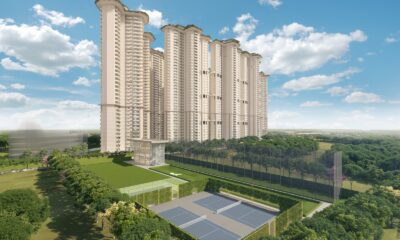News
Occupiers & developers step up towards net-zero journey: Colliers- RICS report


February 24, 2023: Colliers, in partnership with RICS and Australia-India Council participated in a 3-part series of events, around the theme of embodied carbon in built environment and solutions that can enable change. The series aimed at fostering enhanced alliances between Australia and India and facilitating strategic partnerships and collaborations to reduce carbon emissions in built environment. Based on the events, Colliers’ report ‘Enabling net-zero Built Environment’ discusses decarbonization of built sector for a sustainable future.
Decarbonization of the built environment is complex, as construction sector accounts for about 39% of energy-related carbon emissions emanating from building materials, construction and operations. Decarbonization requires rigorous attention across every aspect of building design, construction and operations. This can range from challenges such as limited availability of low carbon building materials and products, lack of proper installation and training to execute highly energy efficient designs, lack of standardized building codes, costing and durability of sustainable materials, and lack of systems for reusing and recycling construction waste etc.


“The real estate sector now has a serious intent to reduce operational emissions over the last few years. Sustainability rating schemes such as LEED and BREEAM have become more popular, signifying the groundwork towards green buildings. At the same time, it is important for businesses to address net zero built environment throughout the life of a building. This starts from material procurement and supply chain to construction completion, and importantly building maintenance. These can be done through aggressive R&D resulting in innovation, and adopting an inclusive approach towards decarbonization”, said Antao Argenio, COO, Colliers India.
Developers’ approach
There is a perceptible shift seen in developers’ preferences towards developing high performing assets to reduce environmental impact. Typically, green buildings are seen to have higher occupancy levels and rental premiums. This has led developers to prioritize sustainability in their real estate portfolios.
- Adopt design led approach wherein measures for decarbonization start from the planning stage
- Addressing areas for improvement in existing buildings, especially in terms of renovations and replacement of materials.
- Aiming for green certifications in early stages of construction
- Efficient management of carbon during deconstruction of building through recycling and reusing residual waste
Occupiers’ approach
Owing to the benefits such as lower operational costs, improved indoor environment, low carbon footprint and stronger brand positioning, occupiers are increasingly preferring high performance buildings. Green buildings also give higher returns and increased workforce productivity.
- Enter green leases with developers
- Reduce operational emissions through efficient space management
- Use of technology to optimize the efficiency in building services
- Mandatory sustainability reporting and climate impact disclosures
Occupiers and developers are increasingly collaborating by entering into green leases, as they advance their commitments towards net-zero transition. Green leases are agreements between landlords and occupiers where both parties undertake specific responsibilities to improve environmental performance of the building.


“Decarbonization of the Built sector is pivotal in achieving global carbon reduction goals, paving the way for a more sustainable and greener and an inclusive future. It is imperative to adopt a lifecycle approach from construction to operation & maintenance and the final disposal of the built structure. This necessitates a collaborative approach amongst investors, developers, and occupiers to achieve net-zero commitment. They need to identify aspects and create strategies around sustainability, to especially lower carbon emissions,” said Vimal Nadar, Senior Director and Head of Research, Colliers India.
Government’s approach
- Increasing investments in R&D
- Create standardized building codes
- Provide incentives for green retrofitting and development of high-performance buildings
- Targeted education at various levels
The government is also currently revisiting its existing environment policies and is making efforts to make them more holistic and comprehensive. Initiatives such as Green Hydrogen policy, National solar mission are expected to further boost decarbonization efforts in the country.
-



 News4 weeks ago
News4 weeks agoKW Delhi 6 Mall Onboards New Brands
-



 News4 weeks ago
News4 weeks agoCommercial Realty Gets Tech Savvy: Fast Construction, Enhanced Convenience
-



 News3 weeks ago
News3 weeks agoGodrej Properties Sells Rs 3k cr+ Homes of Godrej Zenith, Gurugram, within 3 days
-



 News4 weeks ago
News4 weeks agoRBI’s Status Quo on Key Policy Rates to Help Maintain the Real Estate Growth Momentum, Say Industry Stalwarts
-



 News2 weeks ago
News2 weeks agoOlive Announces Dhruv Kalro as Co-Founder
-



 News2 weeks ago
News2 weeks agoNoida’s High-Rise Societies Face Multiple Challenges Despite Rapid Urban Growth
-



 News3 weeks ago
News3 weeks agoGodrej Properties Sells 5000+ Homes of Rs 9.5 cr in Q4FY24, Bookings up 84% YoY
-



 News2 weeks ago
News2 weeks agoVestian: Domestic Investors Dominate Institutional Investments in Jan-Mar’24

















